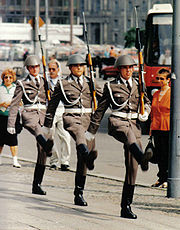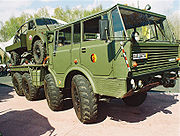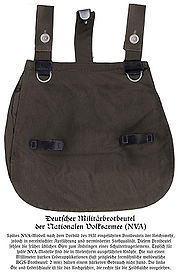
Landstreitkräfte
Encyclopedia

Army
An army An army An army (from Latin arma "arms, weapons" via Old French armée, "armed" (feminine), in the broadest sense, is the land-based military of a nation or state. It may also include other branches of the military such as the air force via means of aviation corps...
or Heer
Heer
Heer is German for "army". Generally, its use as "army" is not restricted to any particular country, so "das britische Heer" would mean "the British army".However, more specifically it can refer to:*An army of Germany:...
, was the ground based military branch
Military branch
Military branch is according to common standard the subdivision of the national armed forces of a sovereign nation or state...
of the East German National People's Army
National People's Army
The National People’s Army were the armed forces of the German Democratic Republic .The NVA was established in 1956 and disestablished in 1990. There were frequent reports of East German advisors with Communist African countries during the Cold War...
. The Land Forces Command, located at Geltow was established on 1 December 1972 as a management body created for the land forces. The NPA itself was created on March 1, 1956 from the Kasernierte Volkspolizei
Kasernierte Volkspolizei
Kasernierte Volkspolizei were the military units of the Volkspolizei in the German Democratic Republic...
(Barracked People's Police).
Organisation

Military District North
The headquarter of the northern district was in NeubrandenburgNeubrandenburg
Neubrandenburg is a city in Mecklenburg-Vorpommern, Germany. It is located in the southeastern part of the state, on the shore of a lake called the Tollensesee ....
.


Potsdam
Potsdam is the capital city of the German federal state of Brandenburg and part of the Berlin/Brandenburg Metropolitan Region. It is situated on the River Havel, southwest of Berlin city centre....
)
- Mot.-Schützenregiment 1 Hans Beimler
- Mot.-Schützenregiment 2 Arthur Ladwig
- Mot.-Schützenregiment 3 Paul Hegenbarth
- Panzerregiment 1 Friedrich Wolf
- Artillerieregiment 1 Rudolf Gypner
- Führungsbatterie Chef Raketen/Artillerie 1
- Fla-Raketen Regiment 1 Anton Fischer
- Führungsbatterie Chef Truppenluftabwehr 1
- Raketenabteilung 1 Rudi Arndt
- Schwere Werferabteilung 1 Hermann Rentzsch
- Aufklärungsbatallion 1 Dr. Richard Sorge
- Pionierbatallion 1 Willi Becker
- Panzerjägerabteilung 1
- Nachrichtenbatallion 1 Bodo Uhse
- Battalion Materielle Sicherstellung 1 Georg Handke
- Instandsetzungsbatallion 1 Otto Schliwinski
- Battalion Chemische Abwehr 1 Herbert Kittelmann
- Sanitätsbatallion 1
- Ersatzregiment 1
8. Motorisierte-Schützen-Division (Schwerin
Schwerin
Schwerin is the capital and second-largest city of the northern German state of Mecklenburg-Vorpommern. The population, as of end of 2009, was 95,041.-History:...
)
- Mot.-Schützenregiment 27 Hans Kahle
- Mot.-Schützenregiment 28 Wilhelm Florin
- Mot.-Schützenregiment 29 Ernst Moritz Arndt
- Panzerregiment 8 Arthur Becker
- Artillerieregiment 8 Erich Mühsam
- Führungsbatterie Chef Raketen/Artillerie 8
- Fla-Raketen Regiment 8 Willi Schröder
- Führungsbatterie Chef Truppenluftabwehr 8
- Raketenabteilung 8 Hermann Schuldt
- Schwere Werferabteilung 8 Mathias Thesen
- Aufklärungsbatallion 8 Otto Moritz
- Pionierbatallion 8 Tudor Vladimirescu
- Panzerjägerabteilung 8 Heinrich Dollwetzel
- Nachrichtenbatallion 8 Kurt Bürger
- Battalion Materielle Sicherstellung 8 Herbert Tschäpe
- Instandsetzungsbatallion 8 Wilhelm Pieck
- Battalion Chemische Abwehr 8 Erich Correns
- Sanitätsbatallion 8 Hans Rodenberg
- Ersatzregiment 8
9. Panzerdivision (Eggesin
Eggesin
Eggesin is a municipality in the Vorpommern-Greifswald district, in Mecklenburg-Western Pomerania, Germany. It is situated on the river Uecker, 7 km southeast of Ueckermünde, and 42 km northwest of Szczecin.-Transport:...
)
- Panzerregiment 21 Walter Empacher
- Panzerregiment 22 Soja Kosmodemjanskaja
- Panzerregiment 23 Julian Marchlewski
- Mot.-Schützenregiment 9 Rudolf Renner
- Artillerieregiment 9 Hans Fischer
- Führungsbatterie Chef Raketen/Artillerie 9
- Fla-Raketen Regiment 9 Rudolf Dölling
- Führungsbatterie Chef Truppenluftabwehr 9
- Raketenabteilung 9 Otto Nuschk
- Schwere Werferabteilung 9 Friedrich Ebert
- Aufklärungsbatallion 9 Eduard Claudius
- Pionierbatallion 9
- Nachrichtenbatallion 9 Adolf Bytzeck
- Battalion Materielle Sicherstellung 9 Robert Stamm
- Instandsetzungsbatallion 9 Paul Dessau
- Battalion Chemische Abwehr 9 Michael Niederkirchner
- Sanitätsbatallion 9 Wolfgang Langhoff
- Ersatzregiment 9
Military District South
The headquarter of the southern district was in LeipzigLeipzig
Leipzig Leipzig has always been a trade city, situated during the time of the Holy Roman Empire at the intersection of the Via Regia and Via Imperii, two important trade routes. At one time, Leipzig was one of the major European centres of learning and culture in fields such as music and publishing...
.
4. Motorisierte-Schützen-Division (Erfurt
Erfurt
Erfurt is the capital city of Thuringia and the main city nearest to the geographical centre of Germany, located 100 km SW of Leipzig, 150 km N of Nuremberg and 180 km SE of Hannover. Erfurt Airport can be reached by plane via Munich. It lies in the southern part of the Thuringian...
)
- Mot.-Schützenregiment 22 Thomas Müntzer
- Mot.-Schützenregiment 23 Anton Saefkow
- Mot.-Schützenregiment 24 John Scheer
- Panzerregiment 4 August Bebel
- Artillerieregiment 4 Willi Bredel
- Führungsbatterie Chef Raketen/Artillerie 4
- Fla-Raketen Regiment 4 Hermann Danz
- Führungsbatterie Chef Truppenluftabwehr 4
- Raketenabteilung 4
- Schwere Werferabteilung 4
- Aufklärungsbatallion 4 Wilhelm Girnius
- Pionierbatallion 4 Walter Kaiser-Gorrish
- Panzerjägerabteilung 4 Franz Jacob
- Nachrichtenbatallion 4
- Battalion Materielle Sicherstellung 4
- Instandsetzungsbatallion 4
- Battalion Chemische Abwehr 4
- Sanitätsbatallion 4
- Ersatzregiment 4
11. Motorisierte-Schützen-Division (Halle
Halle, Saxony-Anhalt
Halle is the largest city in the German state of Saxony-Anhalt. It is also called Halle an der Saale in order to distinguish it from the town of Halle in North Rhine-Westphalia...
)
- Mot.-Schützenregiment 16 Robert Uhrig
- Mot.-Schützenregiment 17 Fritz Weineck
- Mot.-Schützenregiment 18 Otto Schlag
- Panzerregiment 11 Otto Buchwitz
- Artillerieregiment 11 Wilhelm Koenen
- Führungsbatterie Chef Raketen/Artillerie 11
- Fla-Raketen Regiment 11 Georg Stöber
- Führungsbatterie Chef Truppenluftabwehr 11
- Raketenabteilung 11 Magnus Poser
- Schwere Werferabteilung 11
- Aufklärungsbatallion 11 Heinrich Brandes
- Pionierbatallion 11 Willi Gall
- Panzerjägerabteilung 11 Hermann Vogt
- Nachrichtenbatallion 11 Otto Brosowski
- Battalion Materielle Sicherstellung 11 Bernhard Koenen
- Instandsetzungsbatallion 11
- Battalion Chemische Abwehr 11 Erwin Hörnle
- Sanitätsbatallion 11
- Ersatzregiment 11
7. Panzerdivision (Dresden
Dresden
Dresden is the capital city of the Free State of Saxony in Germany. It is situated in a valley on the River Elbe, near the Czech border. The Dresden conurbation is part of the Saxon Triangle metropolitan area....
)
- Panzerregiment 14 Karol Swierczewski
- Panzerregiment 15 Paul Hornick
- Panzerregiment 16 Leo Jogiches
- Mot.-Schützenregiment 7 Max Roscher
- Artillerieregiment 7 Albert Hößler
- Führungsbatterie Chef Raketen/Artillerie 7
- Fla-Raketen Regiment 7 Paul Rockstroh
- Führungsbatterie Chef Truppenluftabwehr 7
- Raketenabteilung 7 Alfred Kurella
- Schwere Werferabteilung 7 Ernst Schneller
- Aufklärungsbatallion 7 Ludvik Svoboda
- Pionierbatallion 7 Arthur Thiermann
- Nachrichtenbatallion 7 Egon Dreger
- Battalion Materielle Sicherstellung 7 Kurt Schlosser
- Instandsetzungsbatallion 7 Gustav Schneider
- Battalion Chemische Abwehr 7 Johann Eggert
- Sanitätsbatallion 7
- Ersatzregiment 7
Second line divisions
In the event of a full-scale mobilisation, the six regular divisions of the NVA would have been supplemented by three mobilisation divisions and two reserve divisions. All five divisions would be mobilised on M+2. The cadre of each mobilisation/reserve division remained on hand as the regular staff of training centers/non-commissioned officer (NCO) schools. The five second line divisions were the 6th Motor Rifle Division (Königswartha), the 10th Motor Rifle Division (Ronneburg), the 17th Motorisierte-Schützen-Division (HQ Petersroda), the 19th Motorisierte-Schützen-Division (HQ Wulkow, which was not based on a training centre), and the 20th Motorisierte-Schützen-Division (HQ Bredenfelde).Other units
The Kommando Landstreitkräfte also contained some specially trained units - like the 40. Fallschirmjägerbataillon Willi Sänger40. Fallschirmjägerbataillon Willi Sänger
40. Fallschirmjägerbataillon Willi Sänger was the only airborne infantry formation of the East German National People’s Army . The battalion was based in Prora on Rügen island and later near Potsdam...
. The structure and equipment was mostly of Soviet design, and the NVA operated in close collaboration with the Group of Soviet Forces in Germany
Group of Soviet Forces in Germany
The Group of Soviet Forces in Germany , also known as the Group of Soviet Occupation Forces in Germany and the Western Group of Forces were the troops of the Soviet Army in East Germany....
. There were also reports of a special NVA diversionary
Special forces
Special forces, or special operations forces are terms used to describe elite military tactical teams trained to perform high-risk dangerous missions that conventional units cannot perform...
battalion in south Germany equipped with M-48s and M-113s, able to cause confusion amongst NATO forces if war came (thus emulating and improving on the example of Otto Skorzeny
Otto Skorzeny
Otto Skorzeny was an SS-Obersturmbannführer in the German Waffen-SS during World War II. After fighting on the Eastern Front, he was chosen as the field commander to carry out the rescue mission that freed the deposed Italian dictator Benito Mussolini from captivity...
's Panzerbrigade 150 during the Ardennes Offensive). However more recent reports throw doubt on the existence of any such unit.
Types of units
Divisions- Motorisierte-Schützen-Division (motorised/mechanized infantry division)
- Panzerdivision (tank division)
Regiments
- Artillerieregiment (artilleryregiment)
- Ersatzregiment (replacement regiment)
- Fla-Raketen Regiment (AA-missile regiment)
Battalions
- Aufklärungsbatallion (reconnaissance battalion)
- Battalion Chemische Abwehr (chemical-defence battalion)
- Battalion Materielle Sicherstellung (material security battalion)
- Führungsbatterie Chef Raketen/Artillerie (rocket/artillery control battery)
- Führungsbatterie Chef Truppenluftabwehr (aa-missile control battery)
- Instandsetzungsbatallion (repair battalion)
- Nachrichtenbatallion (signal battalion)
- Pionierbatallion (engineer battalion)
- Sanitätsbatallion (medical battalion)
Detachments
- Panzerjägerabteilung (light AT-detachment)
- Raketenabteilung (rocket detachment)
- Schwere Werferabteilung (heavy mortar detachment)
Personal Arms
- Makarov PMMakarov PMThe PM is a semi-automatic pistol design. Under the project leadership of Nikolay Fyodorovich Makarov, it became the Soviet Union's standard military side arm from 1951-1991.-Development:...
semi-automatic pistol - AK-74AK-74The AK-74 is an assault rifle developed in the early 1970s in the Soviet Union as the replacement for the earlier AKM...
automatic carbine - RPDRPDThe RPD is a 7.62mm light machine gun developed in the Soviet Union by Vasily Degtyaryov for the intermediate 7.62x39mm M43 cartridge. It was created as a replacement for the DP machine gun chambered for the 7.62x54mmR Mosin rifle round...
- RPKRPKThe RPK is a 7.62x39mm light machine gun of Soviet design, developed by Mikhail Kalashnikov in the late 1950s, parallel with the AKM assault/battle rifle...
- PKMPK machine gunThe PK is a 7.62 mm general-purpose machine gun designed in the Soviet Union and currently in production in Russia. The PK machine gun was introduced in the 1960s and replaced the SGM and RPD machine guns in Soviet service...
- Dragunov SVD semi-automatic sniper rifle
- RPG-7RPG-7The RPG-7 is a widely-produced, portable, unguided, shoulder-launched, anti-tank rocket-propelled grenade launcher. Originally the RPG-7 and its predecessor, the RPG-2, were designed by the Soviet Union, and now manufactured by the Bazalt company...
D light AT-weapon - RPG-18RPG-18The RPG-18 Mukha is a Russian short-range, disposable light anti-tank rocket launcher.-History:The RPG-18 is very similar to the US M72-series LAW anti-tank rocket and was developed after the Soviet military obtained M72s from its allies in Vietnam...
light AT-weapon
Armored Vehicles
- BMP-1BMP-1The BMP-1 is a Soviet amphibious tracked infantry fighting vehicle. BMP stands for Boyevaya Mashina Pekhoty 1 , meaning "infantry fighting vehicle". The BMP-1 was the world's first mass-produced infantry fighting vehicle...
- BMP-2BMP-2The BMP-2 is a second-generation, amphibious infantry fighting vehicle introduced in the 1980s in the Soviet Union, following the BMP-1 of the 1960s....
- BRDM-1BRDM-1The BRDM-1 was an amphibious armored scout car used by Russia and the former Soviet Union...
- BRDM-2BRDM-2The BRDM-2 is an amphibious armoured patrol car used by Russia and the former Soviet Union. It was also known under designations BTR-40PB, BTR-40P-2 and GAZ 41-08...
- BTR-40BTR-40The BTR-40 is a Soviet non-amphibious, wheeled armoured personnel carrier and reconnaissance vehicle. It is often referred to as the Sorokovka in Soviet service. It is also the first mass-produced Soviet APC...
- BTR-50BTR-50The BTR-50 The BTR-50 The BTR-50 (BTR stands for Bronetransporter (БТР, Бронетранспортер, literally "armored transporter") is a Soviet amphibious armored personnel carrier (APC) based on the PT-76 light tank. The BTR-50 is tracked, unlike most in the BTR series, which are wheeled. The BTR-50...
- BTR-60BTR-60The BTR-60 is the first vehicle in a series of Soviet eight-wheeled armoured personnel carriers. It was developed in the late 1950s as a replacement for the BTR-152 and was seen first time in public in 1961...
- BTR-70BTR-70The BTR-70 is an eight-wheeled armored personnel carrier , originally developed during the late 1960s under the industrial designator GAZ-4905. On August 21, 1972, it was accepted into service and would later be exported to the Warsaw Pact and other allies...
- BTR-152BTR-152The BTR-152 was a non-amphibious Soviet wheeled armored personnel carrier that entered Soviet service in 1950. By the early 1970s it had been replaced in the infantry vehicle role by the BTR-60...
- PT-76PT-76The PT-76 is a Soviet amphibious light tank which was introduced in the early 1950s and soon became the standard reconnaissance tank of the Soviet Army and the other Warsaw Pact armed forces. It was widely exported to other friendly states, like India, Iraq, North Korea and North Vietnam. Overall,...
- T-54
- T-55T-55The T-54 and T-55 tanks were a series of main battle tanks designed in the Soviet Union. The first T-54 prototype appeared in March 1945, just before the end of the Second World War. The T-54 entered full production in 1947 and became the main tank for armored units of the Soviet Army, armies of...
- T-72T-72The T-72 is a Soviet-designed main battle tank that entered production in 1970. It is developed directly from Obyekt-172, and shares parallel features with the T-64A...
Further reading
- Dale Roy Herspring, Requiem for an army: the demise of the East German military, Rowman & Littlefield Publishers, 1998, ISBN 084768718X, 9780847687183, 249 pages
- Jörg SchönbohmJörg SchönbohmJörg Schönbohm is a German politician and a retired Lieutenant General. He was the first commander of the Bundeswehr Eastern Command in 1990, which supervised the absorption of the East German National People's Army into the Federal German armed forces...
, Two armies and one fatherland: the end of the Nationale Volksarmee, Berghahn Books, 1996, ISBN 1571810692, 9781571810694 - Zilian, Jr., Frederick. 'From Confrontation to Cooperation: The Takeover of the National People's (East German) Army by the Bundeswehr,' Praeger, Westport, Conn., 1999, ISBN 0-275-96546-5. Reviewed by Dale R. Herspring in The Journal of Military History, July 2000, p. 912-914

